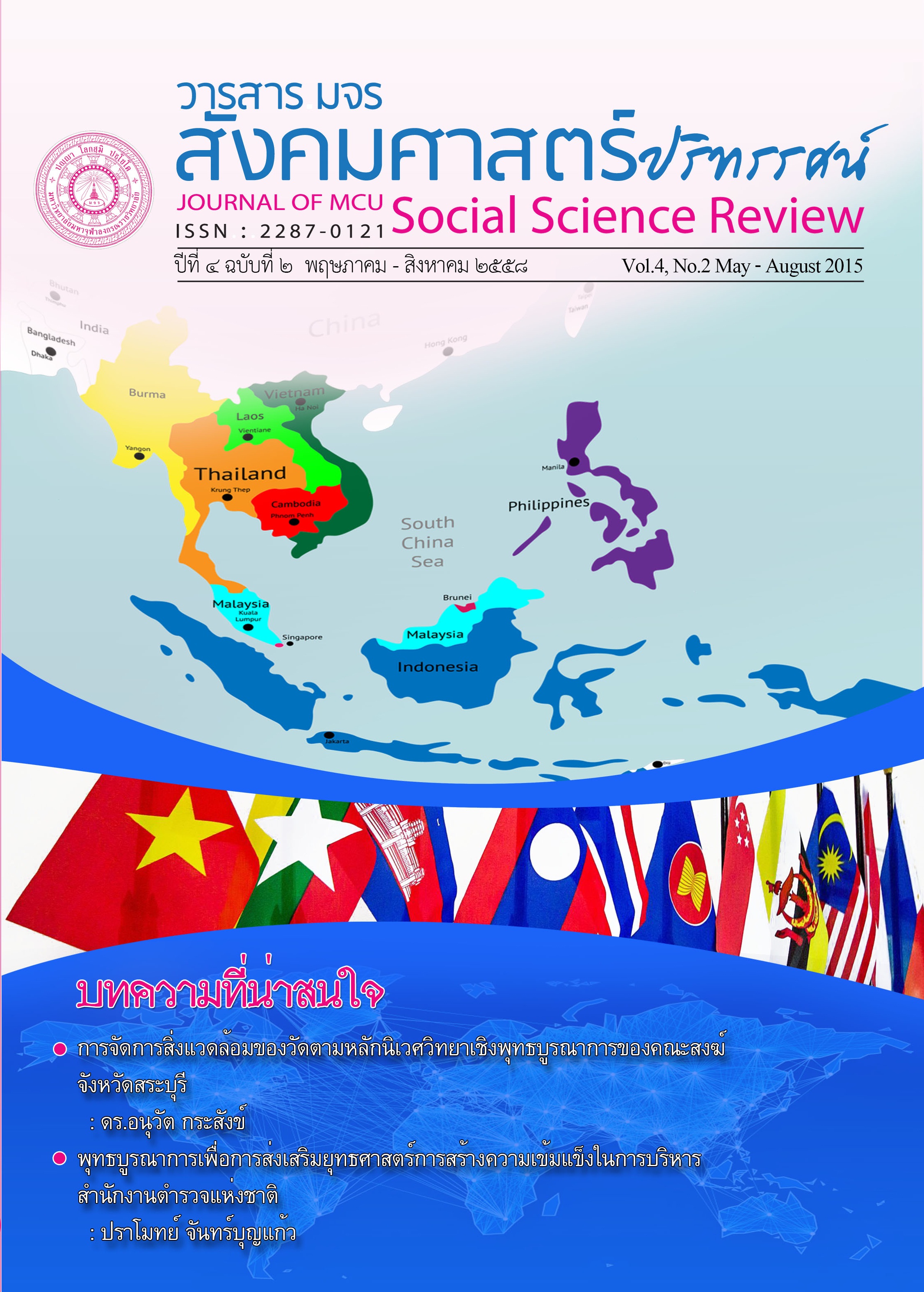ความสําเร็จของโครงการเผยแผ่ธรรมะวัดพระธรรมกายในยุคโลกาภิวัตน์
คำสำคัญ:
ความสำเร็จ, ศาสนธรรม, ผู้นำสงฆ์บทคัดย่อ
การวิจัยเรื่องความสําเร็จของโครงการเผยแผ่ธรรมะวัดพระธรรมกายในยุคโลกาภิวัตน์ มี วัตถุประสงค์เพื่อ ๑) ศึกษาความสําเร็จของการเผยแผ่ธรรมะของวัดพระธรรมกายในยุคโลกาภิวัตน์ ๒) วิเคราะห์ปัจจัยเชิงสาเหตุที่ส่งผลต่อความสําเร็จของการเผยแผ่ธรรมะของวัดพระธรรมกายในยุค โลกาภิวัตน์ และ ๓) นําเสนอตัวแบบการเผยแผ่ธรรมะของวัดพระธรรมกายในยุคโลกาภิวัตน์ การ วิจัยนี้เป็นแบบผสานวิธี การวิจัยเชิงคุณภาพ ใช้การสัมภาษณ์เจาะลึกจากบุคคลที่เป็นผู้มีบทบาท สําคัญในการจัดทําโครงการ และการวางแผนการบริหารโครงการเผยแผ่ธรรมะของวัดพระธรรมกาย รวม ๒๔ คน ที่เลือกแบบเจาะจง ส่วนการวิจัยเชิงปริมาณ ได้กลุ่มตัวอย่าง จํานวน ๓๗๖ คน ตาม สูตรของทาโร ยามาเน จากผู้ที่เข้าร่วมโครงการใน ๖ จังหวัด สุ่มตัวอย่างแบบแบ่งชั้นภูมิ และการ สุ่มแบบง่าย เครื่องมือการเก็บข้อมูลใช้แบบสอบถาม วิเคราะห์ข้อมูลเชิงคุณภาพด้วยการวิเคราะห์ แบบอุปนัย และใช้สถิติขั้นพื้นฐานวิเคราะห์ข้อมูลเชิงปริมาณ ได้แก่ การแจกแจงความถี่ ค่าร้อยละ ค่าเฉลี่ย และส่วนเบี่ยงเบนมาตรฐาน
ผลการวิจัยพบว่า
๑) ความสําเร็จของโครงการเผยแผ่ธรรมะของวัดพระธรรมกายสะท้อนภาพแห่ง ความสําเร็จ ๔ มิติ คือ (๑) ด้านศาสนธรรม เป็นการประยุกต์ใช้หลักธรรมะขั้นพื้นฐานให้สอดคล้อง กับชีวิตประจําวันและใช้ภาษาที่เข้าใจง่าย (๒) ด้านศาสนบุคคล เป็นการบูรณาการองค์ความรู้ด้าน การจัดการทรัพยากรมนุษย์สมัยใหม่กับการใช้หลักธรรมะเป็นแนวทางในการฝึกอบรม รวมถึงการมีหลักการขั้นพื้นฐาน เช่น หลักคุณธรรม ๓ นิสสัย ๕ และ ๕ ห้องชีวิต ฯลฯ อยู่ในกระบวนการ ฝึกอบรมด้วย (๓) ด้านศาสนพิธีกรรม เป็นการสืบสานวัฒนธรรมประเพณีชาวพุทธให้คงอยู่สืบไป (๔) ด้านศาสนสถาน มีหลักการสําคัญ คือ มั่นคงแข็งแรง ประหยัด ประโยชน์สูงสุด
๒) ปัจจัยด้านหลักธรรมที่ใช้ในการอบรม ปัจจัยด้านกระบวนการบริหารโครงการ ปัจจัย ด้านศรัทธาของประชาชน ล้วนส่งผลต่อผลสัมฤทธิ์ของโครงการเผยแผ่ธรรมะของวัดพระธรรมกาย ในยุคโลกาภิวัตน์ทั้งสิ้น
๓) ตัวแบบของผลสัมฤทธิ์ของโครงการเผยแผ่ธรรมะของวัดพระธรรมกายในยุคโลกาภิ วัตน์พัฒนาขึ้นจากการยึดถือหลักสําคัญในทางพระพุทธศาสนา ได้แก่ ศีล สมาธิ และปัญญา เป็น แนวทางการพัฒนา โดยอาศัยภาวะผู้นําสงฆ์ของเจ้าอาวาสเป็นผู้ดําริโครงการและมีคณะทํางาน แปลงตํารีให้กลายเป็นโครงการสําคัญของวัด
เอกสารอ้างอิง
(๑) หนังสือ
นาตยา แก้วใส และผะอบ พวงน้อย. บทบาทวัดพระธรรมกายในการใช้เทคโนโลยีสารสนเทศเผยแผ่พระพุทธศาสนาทั่วโลก, กรุงเทพมหานคร: สํานักงานคณะกรรมการวัฒนธรรมแห่งชาติกระทรวงศึกษาธิการ, ๒๕๔๒ พระธรรมปิฎก (ป.อ. ยุตโต), บุญ-บารมี ที่จะกู้แผ่นดินไทย. กรุงเทพมหานคร: กรมการศาสนา,๒๕๔๓
พระมหาสมชาย ฐานวุฑโฒ, มงคลชีวิตฉบับทางก้าวหน้า, ปทุมธานี: มูลนิธิธรรมกาย. ๒๕๕๑
พระภาวนาวิริยคุณ. ศรัทธา รุ่งอรุณแห่งสันติภาพโลก. ปทุมธานี: กองวิชาการ อาศรมบัณฑิต๒๕๕๑.
พระโสภณธรรมวาที (บุญมา อาคมปุญโญ) เคล็ดลับกับศิลปะการเทศน์, กรุงเทพมหานคร: ศิลป์สยามบรรจุภัณฑ์และการพิมพ์, ๒๕๔๔.
แสง จันทร์งาม, พุทธศาสนากับสังคมไทย. กรุงเทพมหานคร: มหามกุฏราชวิทยาลัย, ๒๕๔๐.
(๒) วิทยานิพนธ์/งานวิจัย
พระมหาปฐมพงษ์ พัดพาน, การประเมินผลโครงการฝึกอบรมหลักสูตรวิชาการเทศนาขององค์การเผยแผ่วัดประยุรวงศาวาสวรวิหาร กรุงเทพมหานคร. วิทยานิพนธ์พุทธศาสตร มหาบัณฑิต สาขาวิชาพระพุทธศาสนา มหาวิทยาลัยมหาจุฬาลงกรณราชวิทยาลัย,๒๕๕o.
พระมหารุ่งเพชร ชวนปญโญ (พัตทาป) รูปแบบและวิธีการเผยแผ่พุทธธรรมของพระธรรมกิตติวงศ์(ทองดี สุรเตโช), วิทยานิพนธ์พุทธศาสตรมหาบัณฑิต สาขาวิชาพระพุทธศาสนามหาวิทยาลัยมหาจุฬาลงกรณราชวิทยาลัย, ๒๕๔๔.
สนธยา ชมพู, ยุทธศาสตร์การเผยแผ่ศาสนธรรมในยุคโลกาภิวัตน์ กรณีศึกษาวัดพระธรรมกายและวัดหนองป่าพง, วิทยานิพนธ์รัฐประศาสนศาสตรดุษฎีบัณฑิต สาขาวิชารัฐประศาสนศาสตร์ มหาวิทยาลัยราชภัฏวไลยอลงกรณ์ ในพระบรมราชูปถัมภ์, ๒๕๕๒.
อัชวัน หงิมรักษา. กระบวนการขัดเกลาทางสังคมและพัฒนาบุคลากของวัดพระธรรมกาย วิทยานิพนธ์ศิลปศาสตรมหาบัณฑิต สาขาวิชาพุทธศาสน์ศึกษา จุฬาลงกรณ์มหาวิทยาลัย, ๒๕๕๖.
๒. ภาษาอังกฤษ
(1) Book
Edwin Zehner. "Social Honor and Systems of Meaning: A Comment Inspired byHatch". American Anthropologist. 92 (4): 1020-21. 1990.
Hared D.Kasswell. The Structure and Function of Communication. The
Communication of Ideas Limed Bryson en, New York: Harperand RowPublishev, 1948.
K Lapper, Joseph T. The Effects of Mass Communication. New York: The FreePress, 1966.
Rogers, Everett M,with Shoemaker, Floyd F. Communication of Innovations. New York: The Free Press, 1971.
ดาวน์โหลด
เผยแพร่แล้ว
รูปแบบการอ้างอิง
ฉบับ
ประเภทบทความ
สัญญาอนุญาต
ลิขสิทธิ์ (c) 2018 วารสาร มจร สังคมศาสตร์ปริทรรศน์

อนุญาตภายใต้เงื่อนไข Creative Commons Attribution-NonCommercial-NoDerivatives 4.0 International License.
เพื่อให้เป็นไปตามกฎหมายลิขสิทธิ์ ผู้นิพนธ์ทุกท่านต้องลงลายมือชื่อในแบบฟอร์มใบมอบลิขสิทธิ์บทความให้แก่วารสารฯ พร้อมกับบทความต้นฉบับที่ได้แก้ไขครั้งสุดท้าย นอกจากนี้ ผู้นิพนธ์ทุกท่านต้องยืนยันว่าบทความต้นฉบับที่ส่งมาตีพิมพ์นั้น ได้ส่งมาตีพิมพ์เฉพาะในวารสาร มจร สังคมศาสตร์ปริทรรศน์ เพียงแห่งเดียวเท่านั้น หากมีการใช้ภาพหรือตารางหรือเนื้อหาอื่นๆ ของผู้นิพนธ์อื่นที่ปรากฏในสิ่งตีพิมพ์อื่นมาแล้ว ผู้นิพนธ์ต้องขออนุญาตเจ้าของลิขสิทธิ์ก่อน พร้อมทั้งแสดงหนังสือที่ได้รับการยินยอมต่อบรรณาธิการ ก่อนที่บทความจะได้รับการตีพิมพ์ หากไม่เป็นไปตามข้อกำหนดเบื้องต้น ทางวารสารจะถอดบทความของท่านออกโดยไม่มีข้อยกเว้นใดๆ ทั้งสิ้น





